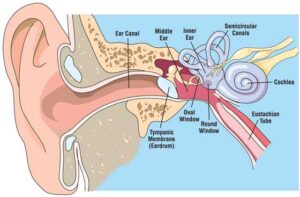Ear injuries happen more frequently than any other type of diving injury. In fact, they occur more often than several of the other most common dive injuries combined. Every time we dive we put our ears through a great deal of stress, but forgetting to equalize or forcing it when we have some congestion can quickly lead to a painful problem.

Middle-Ear Barotrauma
Middle-ear barotrauma (MEBT) occurs when the air pressure within the tympanic cavity (the air-filled space in the middle ear) cannot be equalized with the ambient pressure. Injuries occur when divers fail to equalize, are unable to equalize due to an obstruction of the Eustachian tubes during descent, or forcefully attempt equalization. If the pressure in the tympanic cavity remains lower than the ambient pressure, a relative vacuum in the middle ear will result, causing the eardrum to bulge inward, the tissue of the ear to swell, and fluid and blood from ruptured vessels to leak into the tympanic cavity. Divers with MEBT typically experience a feeling of clogged or stuffy ears followed by mild discomfort to severe pain, and if they descend further, they may risk inner-ear barotrauma or eardrum perforation.
Perforated Eardrum
Perforated eardrum, a tear or perforation of the tympanic membrane, can result from a failure to equalize on descent or a forced Valsalva maneuver; congestion, inadequate training, and descending too quickly can increase the risk of perforating an eardrum. Onset is typically obvious, manifesting as pain (although the rupture may give a short feeling of relief from the squeezing sensation that leads to the perforation) quickly followed by vertigo. Vertigo can be very dangerous underwater, so it’s very important to prevent eardrum perforation. Most perforations will heal spontaneously within a few weeks, but some may require surgical repair. Infections of the middle ear are also common following eardrum perforations that occur while diving.
Inner-Ear Barotrauma
Inner-ear barotrauma (IEBT) can be caused by a failure to equalize sufficiently or a too-aggressive attempt to do so. Underwater, the ambient pressure of the water is significantly higher than the pressure within the middle ear, and without equalization this pressure difference can cause a bulging of the round window, a membrane that separates the middle ear from the inner ear. Even if the round window does not rupture, this can lead to injuries. If the round window does rupture, the loss of fluid in the inner ear can damage hearing and balance organs, and surgery may be required to repair it. Divers with IEBT often experience severe vertigo, hearing loss, tinnitus, a feeling of fullness in their ear and rapid involuntary eye movements known as nystagmus.
Facial Baroparesis
A relatively uncommon but frightening condition, facial baroparesis is the reversible paralysis of a facial nerve due to increased pressure in the middle ear, which can stop circulation to the nerve that’s located near the ear. This can occur while diving or flying, and symptoms usually include numbness, paresthesia, weakness or paralysis of the face. Fortunately, facial baroparesis typically resolves without any medical intervention, but because the facial droop sometimes seen with this condition looks the same as facial droop resulting from a stroke, divers who exhibit any of these symptoms should seek immediate medical attention to rule out a more serious condition.
Fortunately, most ear injuries can be avoided by equalizing early and often, never forcing an equalization and never diving with congestion.






